-
Recent Posts
Archives
Links
general
mission instruments
- CRISM: Compact Reconnaissance Imaging Spectrometer for Mars
- CTX: Context Camera
- HiRISE: High Resolution Imaging Science Experiment
- MARSIS: Mars Advanced Radar for Subsurface and Ionosphere Sounding
- SHARAD: Shallow Radar
- THEMIS: Thermal Emission Imaging System
missions
- All Mars missions list
- Curiosity rover
- ExoMars
- Hope (al-Amal) orbiter
- InSight
- Mars Atmosphere and Volatile Evolution Mission (MAVEN)
- Mars Exploration Rovers (MER)
- Mars Express (MEX)
- Mars Odyssey
- Mars Orbiter Mission (MOM) / Mangalyaan
- Mars Reconnaissance Orbiter (MRO)
- Mars Science Laboratory (MSL)
- Perseverance Rover
- Tianwen-1 orbiter/rover
news
Weather update from Gale Crater
Posted in Reports
Tagged Curiosity, Gale Crater, Mars Science Laboratory, MSL, NASA, temperature, weather
Comments Off
Magnetic Mars engages lay audiences in science
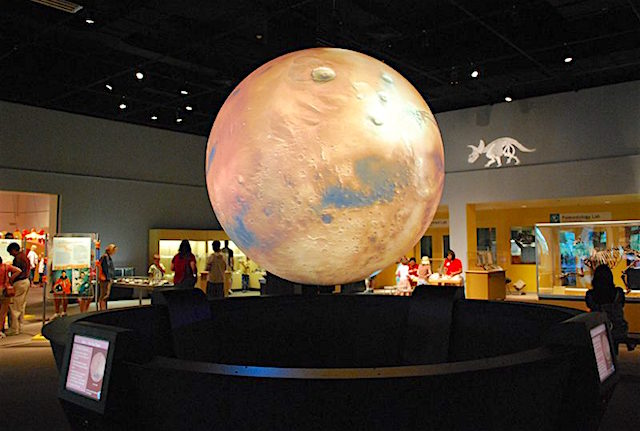 For a cold little planet, Mars remains a hot topic: The general public wants to know more about this alien world and hear from the scientists who study it. Recent findings that highlight tantalizing clues to Mars’s wetter past have piqued this interest still further.
For a cold little planet, Mars remains a hot topic: The general public wants to know more about this alien world and hear from the scientists who study it. Recent findings that highlight tantalizing clues to Mars’s wetter past have piqued this interest still further.
For example, because Mars lacks a global magnetic field, the planet has lost much of its ancient, thicker atmosphere, and much of its carbon dioxide has been lost to space. How habitable was the Red Planet, and what does its history tell us about habitability of other alien worlds?
The public engagement team for NASA’s Mars Atmosphere and Volatile Evolution (MAVEN) mission has developed a series of resources that use current findings from this mission to engage nonscientists in the world of Mars research. These resources have been used successfully by formal and informal educators, museum docents, and planetarium guides to captivate their respective audiences and connect them to a variety of Mars-related science topics.
Scientists can adopt and extend many of these resources to reach another set of potential Mars science enthusiasts. To help, we offer four tips to guide other groups in fully utilizing the rich outreach efforts of MAVEN… [More at link]
Posted in Reports
Tagged atmosphere, Mars Atmosphere and Volatile EvolutioN, MAVEN, NASA, public education, University of Colorado
Comments Off
THEMIS: Solis Planum lava flows and graben
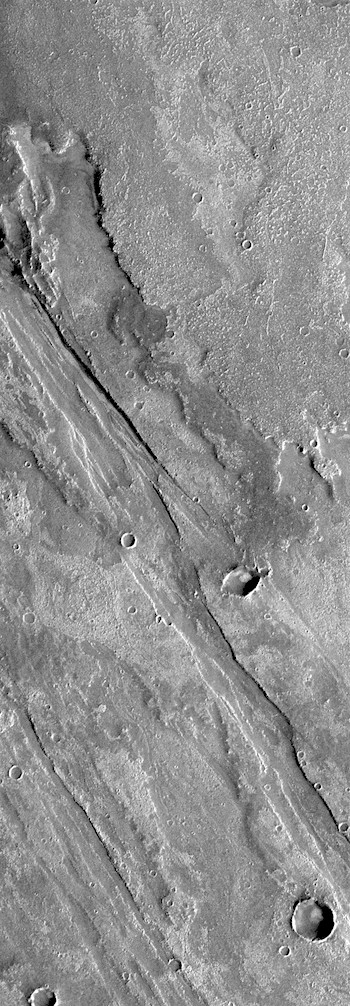 THEMIS Image of the Day, November 30, 2018. Today’s VIS image shows part of Solis Planum. Both volcanic and tectonic forces created the features in this image.
THEMIS Image of the Day, November 30, 2018. Today’s VIS image shows part of Solis Planum. Both volcanic and tectonic forces created the features in this image.
The linear features that run diagonally across the image are fault features called graben. The rough surfaced regions are volcanic flows.
See more THEMIS Images of the Day by geological subject.
Posted in Reports
Tagged Arizona State University, ASU, graben, lava channels, lava flows, Mars Odyssey, NASA, Solis Planum, THEMIS, THEMIS Image of the Day, Thermal Emission Imaging System, volcanics
Comments Off
Curiosity update: Hunting shiny things
 Sol 2245-46, November 28, 2018, update by MSL scientist Suzanne Schwenzer: Curiosity woke up to Mr Rogers “Please would you be my neighbor” this morning to welcome InSight, and then got very busy at the Highfield drill site.
Sol 2245-46, November 28, 2018, update by MSL scientist Suzanne Schwenzer: Curiosity woke up to Mr Rogers “Please would you be my neighbor” this morning to welcome InSight, and then got very busy at the Highfield drill site.
Every plan has its personality, and the upcoming one is that of a gymnast – at least as far as the arm is concerned: Curiosity will dump the Highfield sample, which requires several MAHLI looks and an APXS operation, but the plan also requires swinging the arm out of the way so other instruments can have their unobscured look at the dump pile.
Of course, the main activity is to look at the Highfield dump pile with all instruments available. APXS will get the chemistry, and Navcam, Mastcam and MAHLI will have a close look. In addition, a Mastcam multispectral and a ChemCam passive observation will add to the information collected from the dump pile… [More at link]
Posted in Reports
Tagged Aeolis Mons, Curiosity, Eildon, Flanders Moss, Forres, Gale Crater, Highfield, Jura, Little Colonsay, Little Todday, Mars Science Laboratory, meteorites, Mount Sharp, MSL, Murray Formation, NASA, Vera Rubin Ridge
Comments Off
THEMIS: Youngish crater in Noachis Terra
 THEMIS Image of the Day, November 29, 2018. This VIS image shows half of an unnamed crater in Noachis Terra. The complex rim and rough floor are indicative of a relatively young crater.
THEMIS Image of the Day, November 29, 2018. This VIS image shows half of an unnamed crater in Noachis Terra. The complex rim and rough floor are indicative of a relatively young crater.
With time and erosion, craters fill in with sediment, creating flatter floors and smoothing the overall topography.
Posted in Reports
Tagged Arizona State University, ASU, craters, Mars Odyssey, NASA, Noachis Terra, THEMIS, THEMIS Image of the Day, Thermal Emission Imaging System, young craters
Comments Off
HiRISE: Active dunes in Wirtz Crater
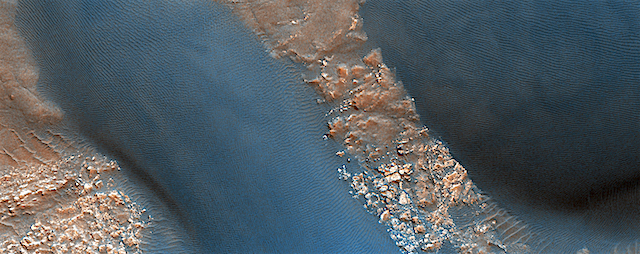 These gorgeous dunes are likely active, with ripples on their upwind slopes and dark streaks on their downwind slopes forming and changing due to wind-driven sand motion.
These gorgeous dunes are likely active, with ripples on their upwind slopes and dark streaks on their downwind slopes forming and changing due to wind-driven sand motion.
This motion will also keep the dune brink (the edge between the two slopes) and bottom edges sharply defined. The dark lines and squiggles on the dune slope are formed by passing dust devils. [More at link]
Posted in Reports
Tagged active dunes, basaltic sand, dust devil tracks, High Resolution Imaging Science Experiment, HiRISE, Mars Reconnaissance Orbiter, MRO, NASA, sand dunes, University of Arizona
Comments Off
Curiosity update: Rover has a minor post-holiday hiccup, but is happy and healthy
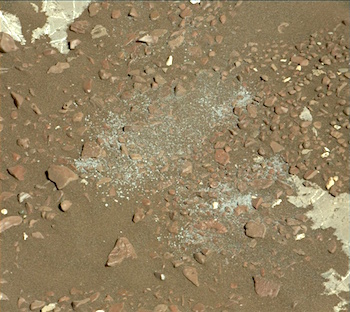 Sol 2243-44, November 26, 2018, update by MSL scientist Lucy Thompson: Curiosity was happy and healthy after the Thanksgiving holiday, but experienced a minor post-holiday hiccup during a test of delivering sample portions to the workspace. The rover’s robotic arm tripped a safety limit such that the activity did not quite go to completion. We should be able to easily recover the rest of this activity in our plan tosol. This should set us up to dump the “Highfield” drill fines later this week, so that we can analyze their chemistry and appearance with APXS, ChemCam, MAHLI and Mastcam, and compare these findings with those from the mineralogical and compositional analyses by Curiosity’s internal instruments, CheMin and SAM.
Sol 2243-44, November 26, 2018, update by MSL scientist Lucy Thompson: Curiosity was happy and healthy after the Thanksgiving holiday, but experienced a minor post-holiday hiccup during a test of delivering sample portions to the workspace. The rover’s robotic arm tripped a safety limit such that the activity did not quite go to completion. We should be able to easily recover the rest of this activity in our plan tosol. This should set us up to dump the “Highfield” drill fines later this week, so that we can analyze their chemistry and appearance with APXS, ChemCam, MAHLI and Mastcam, and compare these findings with those from the mineralogical and compositional analyses by Curiosity’s internal instruments, CheMin and SAM.
As well as recovering the arm activity, we were able to plan a number of science observations to further characterize the bedrock in this workspace, continue our search for meteorites and monitor changes in the wind and sediment movement. ChemCam will analyze the composition of two typical grey bedrock targets, “Kingseat” and “Grampian,” as well as a potential meteorite fragment, “Kerrera,” identified from Mastcam multispectral images… [More at link]
Posted in Reports
Tagged Aeolis Mons, Curiosity, Dunecht, Gale Crater, Grampian, Highfield, Jura, Kerrera, Kingseat, Little Todday, Lothian, Mars Science Laboratory, Mount Sharp, MSL, Murray Formation, NASA, Sand Loch, Vera Rubin Ridge, Windyedge
Comments Off
Evolution of Noachian highlands landscapes
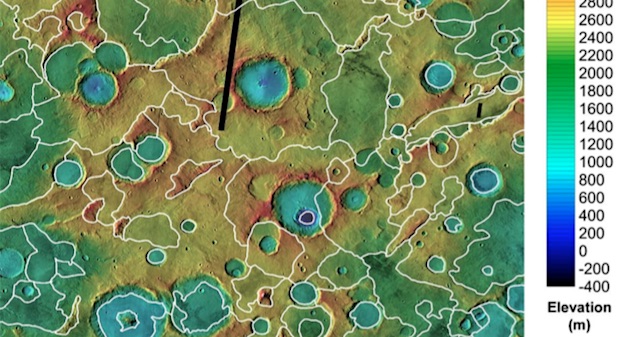 [Editor’s note: From a paper by Jon Cawley and Ross Irwin recently published in the Journal of Geophysical Research.]
[Editor’s note: From a paper by Jon Cawley and Ross Irwin recently published in the Journal of Geophysical Research.]
Evolution of Escarpments, Pediments, and Plains in the Noachian Highlands of Mars
• Debris‐mantled escarpments, regolith pediments, sloping aggradational surfaces, and depositional plains formed on Martian cratered terrain.
• Noachian arid‐zone geomorphology included aqueous weathering of basalt to fines, low‐intensity fluvial erosion, and deposition in basins.
• These processes smoothed and sealed Noachian ejecta blankets, which required little geomorphic work to form stable pediments.
The surface of Mars at Libya Montes, Noachis Terra, and Terra Cimmeria includes steep eroded slopes, gently to moderately sloping stable surfaces, gently sloping low areas that were thinly buried, and flat‐floored basins that accumulated thick deposits of sediment.
The development of these surface features suggests low‐intensity, intermittent erosion by running water and wind over hundreds of millions of years.
The key elements of this landscape evolution include weathering of Martian basaltic bedrock to finer‐grained sediments rather than coarse gravel, a lack of intense rainfall or snowmelt, minimal movement of loose material downslope, and processes that concentrated sediment in basins.
The blankets of material ejected from impact craters required little erosion to form stable and better sealed surfaces, which were later eroded by rivers during brief wetter epochs of Martian history. [More at link]
Posted in Reports
Tagged landscape evolution, Libya Montes, Noachis Terra, Southern Highlands, Terra Cimmeria
Comments Off
ExoMars: Rover fitness trials in Spanish desert
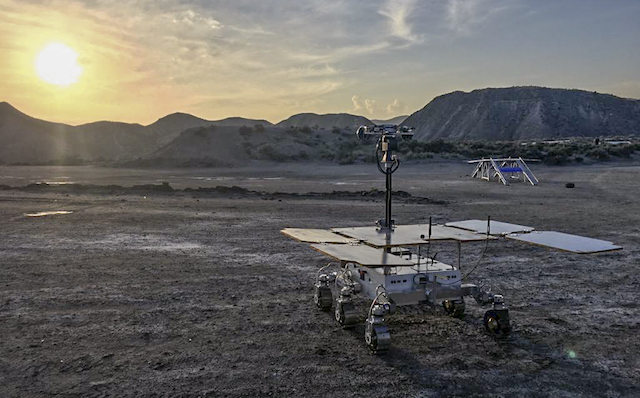 The sun set on a week of trials for the ExoMars rover prototype named Charlie (in the foreground). The first of two field trials for the mission, known as ExoFiT, took place in the Tabernas desert in Spain between 13-26 October.
The sun set on a week of trials for the ExoMars rover prototype named Charlie (in the foreground). The first of two field trials for the mission, known as ExoFiT, took place in the Tabernas desert in Spain between 13-26 October.
While Charlie was located in Spain, mission operators and instrument scientists were based over 1000 km away at mission control in Harwell, UK, near ESA’s ECSAT centre where ExoFit was managed. The distance was crucial as teams operating a rover on the Martian surface must contend with infrequent communication possibilities and must run science operations with what little information they have. The rover itself is designed to carry out activities such as a traverse or observations in between communication blackouts as well as send data to Earth in preparation for the next martian day.
During the 10-day trial, the team practised driving the rover off its landing platform (in the background of this image), targeting sites of interest, and sampling rocks. Decisions were made based on data transmitted by the rover together with maps of the terrain.
Naturally, the team encountered technical difficulties, to be expected in real test conditions. Rainfall disrupted events and forced the team to adapt and optimise their time. In the second week, the team managed to finish activities scheduled for two martian days in a single day… [More at link]
Posted in Reports
Tagged ESA, European Space Agency, ExoMars, ExoMars 2020, ExoMars 2020 rover, Roscosmos, TGO, Trace Gas Orbiter
Comments Off
MARCI weather report, November 19-25, 2018
 Sporadic dust-lifting events continued over both hemispheres of the red planet last week. A few short-lived dust storms were observed along the north polar hood near eastern Acidalia, Alba Mons, and the Phlegra Montes. Amazonis Planitia also encountered a small handful of fleeting local-scale dust storms throughout the week. Meanwhile, on the other side of Mars, remnants of the seasonal south polar ice cap continued to defrost. Transient dust activity was spotted near the edge of the south polar ice cap in the second half of the week. Focusing our attention to the tropics, afternoon water ice clouds… [More at link, including video]
Sporadic dust-lifting events continued over both hemispheres of the red planet last week. A few short-lived dust storms were observed along the north polar hood near eastern Acidalia, Alba Mons, and the Phlegra Montes. Amazonis Planitia also encountered a small handful of fleeting local-scale dust storms throughout the week. Meanwhile, on the other side of Mars, remnants of the seasonal south polar ice cap continued to defrost. Transient dust activity was spotted near the edge of the south polar ice cap in the second half of the week. Focusing our attention to the tropics, afternoon water ice clouds… [More at link, including video]
Posted in Reports
Tagged atmosphere, clouds, dust, dust storms, haze, Malin Space Science Systems, MARCI, Mars Color Imager, Mars Reconnaissance Orbiter, MRO, MSSS, NASA, storms, weather, wind
Comments Off








